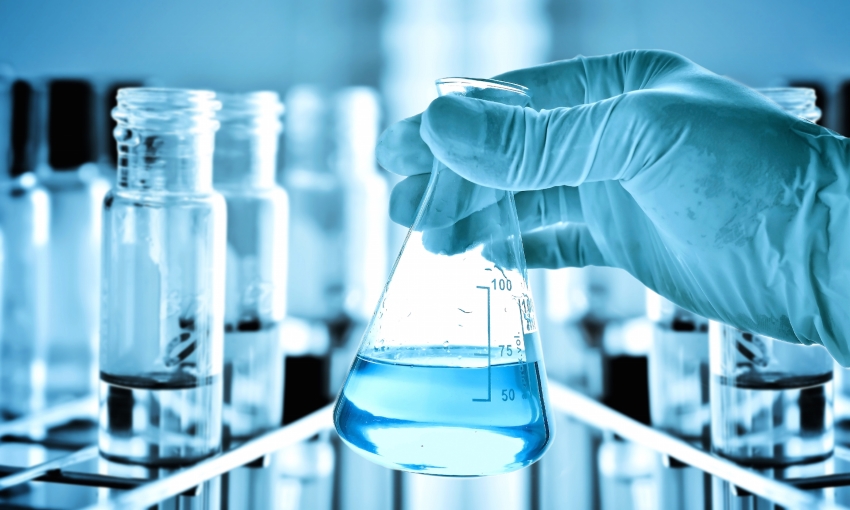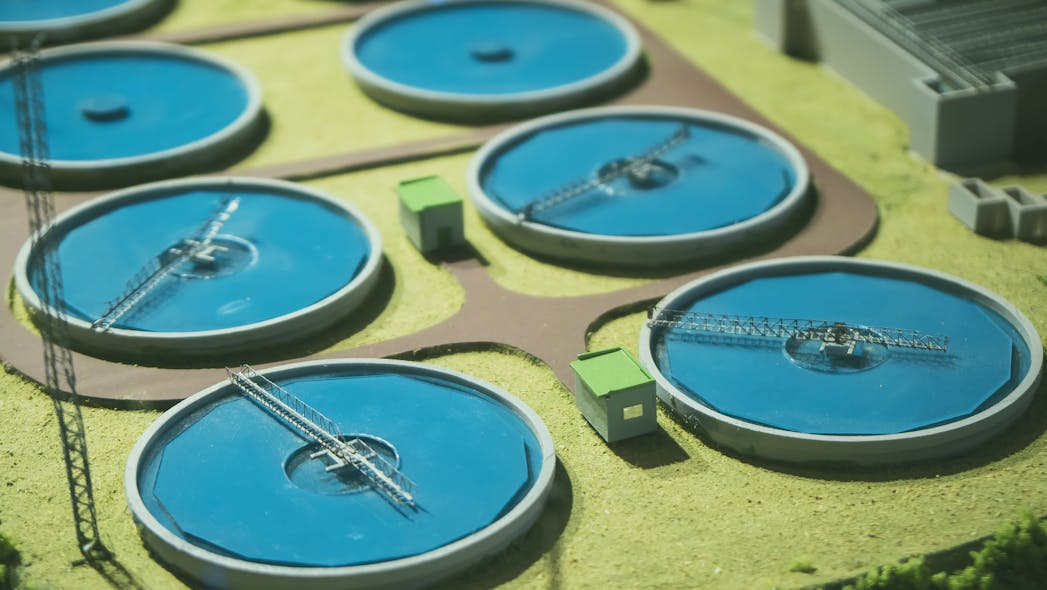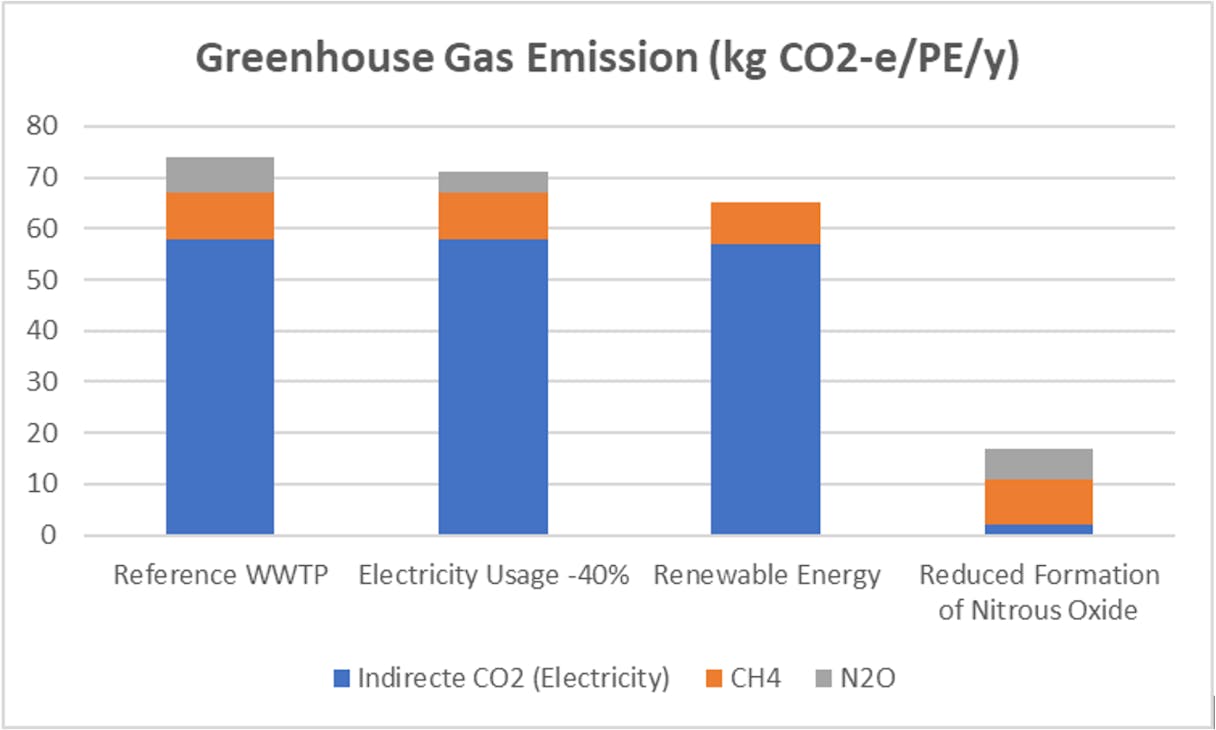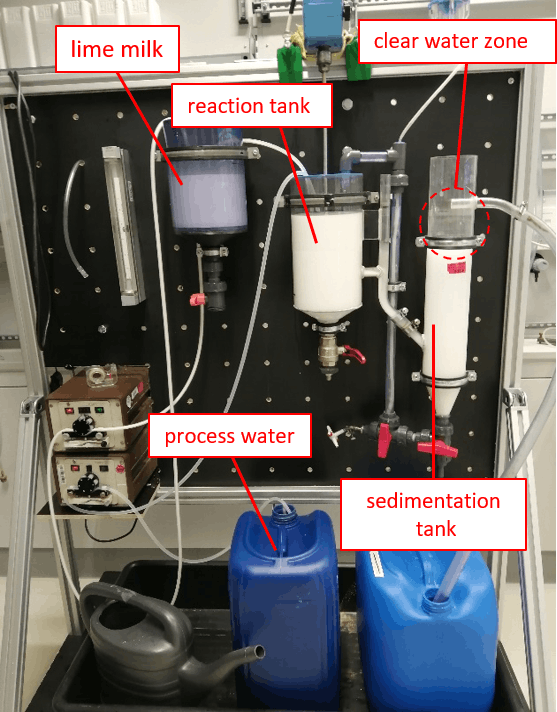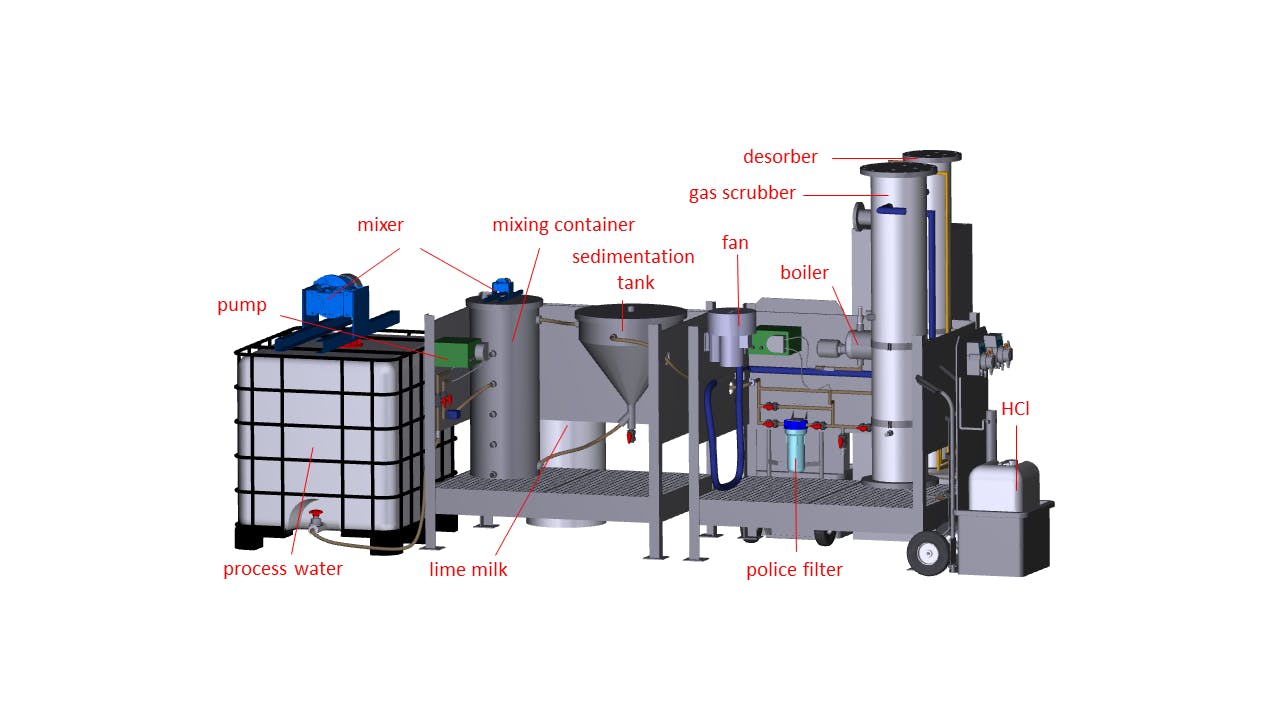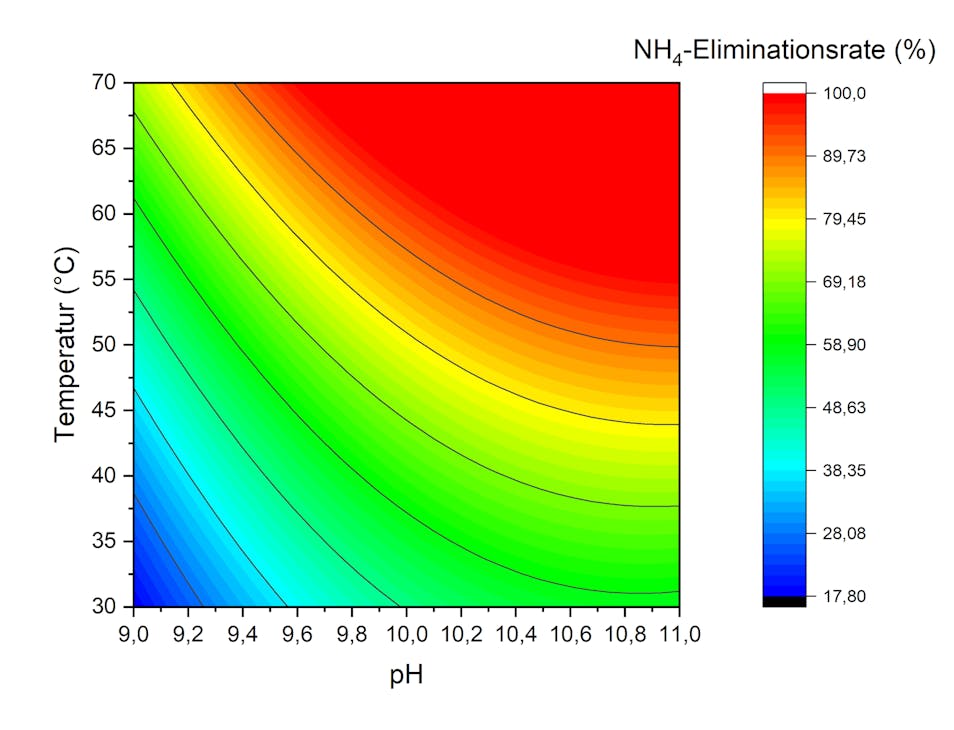The pilot was able to remove nitrogen from the activated sludge state with an increase in capacity, an optimization of power consumption from the aerators (including peak current load in some cases) and a reduction in nitrous oxide emissions, which are the strongest greenhouse gases emitted from wastewater treatment plants.
This investigated method of centrate treatment opens up the possibility of bringing wastewater treatment plants closer to achieving long-term climate neutrality by avoiding or cleaning exhaust gases, especially from sludge treatment and aerated reactors.
With future sector coupling, the improved technology could also be used in more cases than today. This would happen once the by-products of hydrogen electrolysis (mainly pure oxygen and waste heat) can be utilized at the wastewater treatment plant for the separate treatment of centrate as for other process waters, like digester overflows, condensates from sewage sludge drying or incineration, wastewater from exhaust air purification, etc.
Preliminary Remark
There are many new technologies and methodological approaches under discussion for sustainable water management, water finance and water governance (UN, 2015). Some of these are under development or even under implementation.
The most important general aims are to reduce greenhouse gas emissions, other sources of environmental pollution, and to lead the world toward a regenerative economy. The term regenerative economy can be more desirable than the popular term “circular economy,” because it includes the substitution of nonrenewable resources with ones that can regenerate over time.
Big programs in research and international development are focused on solutions which come along with general technological or political changes which, unfortunately, need significant financial budgets and time to be realized. Besides the big projects, it is the small projects and innovations which are needed, especially those which can be implemented in short-term and (in the ideal case) are more profitable than the solutions practiced so far. A small technology-based solution of this kind is the treatment of liquid centrate from sewage sludge dewatering as presented in this article.
Separate Centrate Treatment
The inflow into municipal wastewater treatment plants (WWTP) shows a concentration of ammonium (NH3) typically between 25 and 50 mg/L (DWA 2019). Liquid centrates coming from sewage sludge dewatering as internal backflow of the WWTP contain typically 400 mg/L up to 1000 mg/L of ammonium. Therefore, the idea to treat process waters separately, instead of just pumping it back into the wastewater treatment plant to be co-treated with the mixture of all other wastewaters, is quite obvious. In many cases, the separate treatment of highly concentrated small wastewater flows near-to-source can be done cheaper and more effectively than to co-treat it mixed with other wastewaters.
GWI (2022) has reported that wastewater treatment with activated sludge tanks is by far the major source of N2O emissions, not the sludge handling. This is correct, but not necessarily relevant to determine the best spot for mitigation. Therefore (as well as for the aeration costs for nitrification in activated sludge tanks) it is the major source of nitrogen (like centrate), not the point where the N2O gas is stripped out of the wastewater into the atmosphere.
Separate centrate treatment (SCT) is worthwhile for many WWTPs considering that, usually, the ammonium load [kg NH4+ / d] from centrate accounts for 10% to more than 35% of the total influent load (Jardin, 2003), especially if waste heat is available (e.g. from digester gas-powered combined heat and power plants) to accelerate the SCT process.
The SCT reduces the nitrogen load and thus the electricity consumption for aeration of the activated sludge basins as well as the emissions of climate-damaging nitrous oxide (N2O). In most cases, where the biological stage of the WWTP is already overloaded with nitrogen (often measured against effluent limits that are stricter than before), SCT is financially profitable whenever an extension of the WWTP capacity can be avoided.
In addition, wastewater treatment plants have become part of the public discussion as a source of greenhouse gas emissions. To combat the global climate change, before carbon dioxide (CO2) and methane (CH4) it is nitrous dioxide which plays an important role (UBA, 2022). N2O is 300 times more dangerous for climate than CO2 and 10 times more than CH4. As figure 1 indicates, the greenhouse gas emission unit per population equivalent (PE) can be reduced most effectively by the reduction of N2O, whereas the reduction of electricity consumption or the substitution of fossil through regenerated energy is less effective. This is the case at least for an average WWTP as researched in Switzerland, ETH Zürich, by Gruber et al., 2022.
Despite these economic and ecological advantages of SCT, which can be expected for many sewage treatment plants in Germany (as in other countries with equally stringent environmental and technical standards and expensive power prices), it has not been widely established in practice so far.
One reason is that SCT is not yet considered to be the “proven state of the art”. Malfunctioning SCT plants and poor technical and financial performance have also caused a negative reputation of the technologies in the view of many WWTP operators. Improved technologies are not invented or on the market, yet, or they are not well known.
Furthermore, the quality of centrates is very different between WWTPs. Since laboratory tests do not deliver sufficient results, pilot tests at technical scale are needed in advance as a pre-condition for a reliable case-specific SCT design with data about the expected technical and financial performance. The risk on side of the potential SCT investor is that the costs for pilot-tests arise before he has the data basis to be sure that the SCT is of advantage in the case under investigation and how the SCT can be integrated into the ongoing operation of the WWTP.
Since energy prices have risen, the requirements for sludge treatment have become much more stringent than in the past. On the other hand, the value of reclaimed nutrients (firstly for phosphorus, but also for nitrogen) has increased significantly. Because of this, SCT has become a hot topic for a rising number of WWTP operators and regulators.
Facing this rising popularity, the BMBF (the German Ministry of Education and Research) has decided to sponsor the research project number 02WER1614A entitled “KliPro” about the climate-friendly treatment of WWT process waters like centrate. Under this project, the development of an improved SCT technology with the construction of a pilot plant at a technical scale became possible, which can be used for several WWTPs in succession (EUWID, 2022). With this pilot plant, the entry into SCT as a measure to improve wastewater treatment, energy efficiency and climate protection can now be facilitated.
Selected Technology for SCT
After reviewing literature and oral reports from WWTP operators, the authors found the following concerns regarding the STC technologies:
- The basic technologies applicable for SCT on conventional WWTPs are based on either a biological or chemo-physical process.
- None of the technologies applied so far is recognized as “proven technology” in the sense of a technology which is ready to be applied without functional problems.
- The biological SCT (especially for the effective two-stage version) needs much space which is not available in many existing WWTPs, and it is unable to cope with changes in centrate quality and temperature.
- The chemo-physical SCT comes with costs for chemicals and salinizes the centrate with NaCl if NaOH, caustic soda, is used for alkalinization. These problems are less if Ca(OH)2, limewater, is used, but then incrustation with CaCo3, calcium carbonate, is another problem.
With the expectation that incrustation problems can be resolved and the use of caustic soda avoided, and with the preference for a technology which is easy to automate (smart real time, online process control for remote operational assistance), the team decided to use the chemo-physical technology. This included applying the concept for rapid decarbonization, well-known from supply-waterworks (DVGW 2016, Hahn et a. 2021). However, this concept had to be considerably modified to treat highly contaminated centrate. As a result, the authors devised an improved concept for chemical-physical process water treatment with ammonium stripping.
One new feature is the possibility of selective sedimentation and removal of calcium carbonate (CaCO3) precipitates on a case-by-case basis and the option of increased waste heat utilization. A novel process management with granular sedimentation and partly internal granulate recirculation during the rapid decarbonization leads to longer lifetime of equipment and reduce of operating costs with lower expenditure on chemicals, cleaning and maintenance. In addition, sedimentation aids (sand) can be dispensed with CaCO3 particles.
Figure 2 shows a pre-test at laboratory scale to verify the rapid decarbonization in general. These tests were successful but have revealed that laboratory-scale test results cannot be transferred to design and build full-scale process water treatment plants. Visible in figure 2 is a clearwater zone in the sedimentation compartment with the clean separation of lime water and precipitates.
Development of a pilot plant
The research team designed an SCT pilot plant with the improved rapid decarbonization described above. They also deemed it necessary to construct it as a transportable plant which can be used for different WWTPs without transporting the plant with heavy machinery (big truck, crane, fork-lift etc.). To this end, the pilot plant needed to be built on two separated racks. The high or heavy components (desorber tower and adsorber tower, large tanks, chemical dosing stations, big bags, replacement parts, repair tools etc.) were not permanently fixed on the racks, and could instead be mounted, separated and re-connected in place.
Accordingly, the pilot plant was designed as visualized in the 3-D model figure 3 and is shown as built in the photo figure 4 with the mixer, sedimentation tank and the other main components. The desorber would strip out NH4+, ammonium, as NH3, ammoniac (Gustin 2011), and the adsorber re-solving the ammoniac in water would generate a highly-concentrated ammonium liquid, ready to be used as raw-nitrogen for industrial processing. These re-use technologies had been applied decades ago (Rautenbach et al. 1994) and are continuously being further developed (Endeavor 2022).
Operational Performance of the SCT
Liu simulated the air stripping of ammoniac in 2015. The data resulting from the test-operations of the pilot plant have been evaluated so far, that they could be taken to customize and calibrate different simulation models which calculate the elimination rates of ammonium under different conditions.
At treatment plants for which sufficient hot waste heat is available, the temperature may be set as high as the plant can tolerate (depending on the desorber material and its price). In WWTPs where waste heat is not available, one will probably accept higher CaO consumption to further increase the pH value in order to save thermal energy for heating the centrate up to a higher temperature.
The considerations using tailor made calculations or kind of simulations as in figure 5 are a matter of technical-financial optimization, and these should be done based on the pilot tests in technical scale with the specific centrate and under the specific conditions of the WWTP under discussion.
Provided (1.) that the nitrogen load of the inflow into a WWTP is of relevance, (2.) that the power consumption for nitrification aerators is an issue, (3.) that the ammonium concentration in the centrate is significantly higher than in the WWTP inflow, and that (4.) the size and local working conditions of the WWTP (space, logistics, infrastructure…) are such that a SCT seems could make sense, then it is recommended to carry out preliminary pre-tests in laboratory scale.
If the results of the pre-tests look promising, then pilot tests at technical scale should be executed. However, it seems unlikely that SCT is practicable for plants smaller than 25,000 PE, but very likely of advantage for plants larger than 100,000 PE unless the effluent standards for nitrogen and requirements for sludge management are neglectable.
With future sector coupling (Hagemann 2022, KEK 2022, Büttner 2022), the technology developed in the KliPro project can be used in even more cases than today, if the by-products of hydrogen electrolysis, pure oxygen and waste heat can be used at the WWTP for SCT and other process water treatment.

